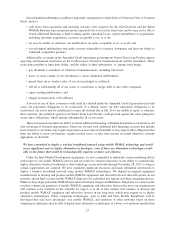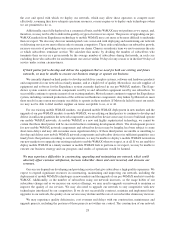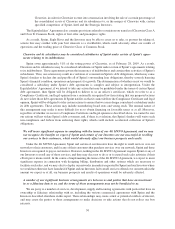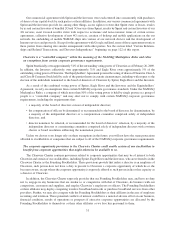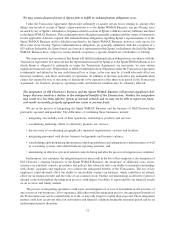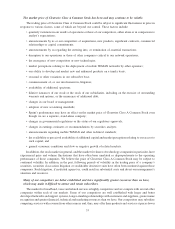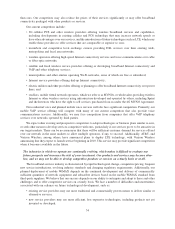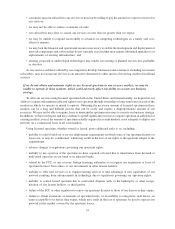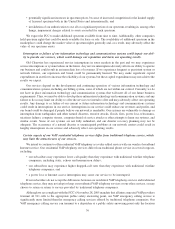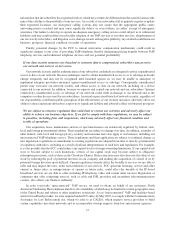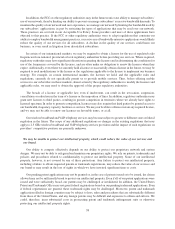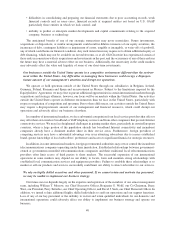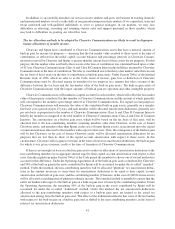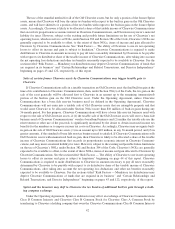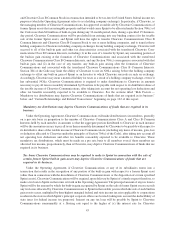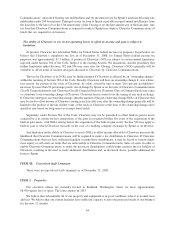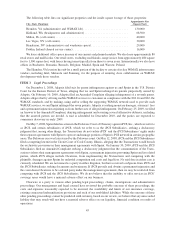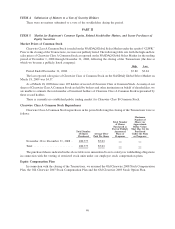Clearwire 2008 Annual Report Download - page 49
Download and view the complete annual report
Please find page 49 of the 2008 Clearwire annual report below. You can navigate through the pages in the report by either clicking on the pages listed below, or by using the keyword search tool below to find specific information within the annual report.i
n
f
ormat
i
on t
h
at t
h
esu
b
scr
ib
er
h
as reg
i
stere
d
w
i
t
h
us, w
hi
c
h
may at t
i
mes
b
e
diff
erent
f
rom t
h
e actua
ll
ocat
i
on at t
h
e
t
ime of the call due to the portabilit
y
of our services. As a result, if our subscribers fail to properl
y
re
g
ister or updat
e
t
heir registered locations, our emergency calling systems may not assure that the appropriate public safet
y
answer
i
ng po
i
nt
i
s reac
h
e
d
an
d
may cause s
i
gn
ifi
cant
d
e
l
ays, or even
f
a
il
ures,
i
nca
ll
ers’ rece
i
pt o
f
emergency
assistance. Our failure to develop or operate an adequate emer
g
enc
y
callin
g
service could sub
j
ect us to substantial
li
a
bili
t
i
es an
d
may resu
l
t
i
n
d
e
l
ays
i
nsu
b
scr
ib
er a
d
opt
i
on o
f
our VoIP serv
i
ces or our ot
h
er serv
i
ces, a
b
an
d
onment o
f
our serv
i
ces
b
ysu
b
scr
ib
ers, an
dli
t
i
gat
i
on costs,
d
amage awar
d
san
d
negat
i
ve pu
bli
c
i
ty, any o
f
w
hi
c
h
cou
ld h
arm ou
r
b
us
i
ness,
p
ros
p
ects,
fi
nanc
i
a
l
con
di
t
i
on or resu
l
ts o
f
o
p
erat
i
ons.
Finally, potential changes by the FCC to current intercarrier compensation mechanisms could result in
sig
n
ifi
cant c
h
an
g
es to our costs o
f
prov
idi
n
g
VoIP te
l
ep
h
on
y
,t
h
ere
by
e
li
m
i
nat
i
n
g
pr
i
c
i
n
gb
ene
fi
ts
b
etween VoI
P
t
elephon
y
services and traditional telephone services and our potential profitabilit
y.
I
f our data security measures are breached or customer data is compromised, subscribers may perceive
o
ur network and services as not secure.
Our networ
k
secur
i
t
y
an
d
t
h
e aut
h
ent
i
cat
i
on o
f
our su
b
scr
ib
er cre
d
ent
i
a
l
s are
d
es
ig
ne
d
to protect unaut
h
or
i
ze
d
access to
d
ata on our networ
k
. Because tec
h
n
i
ques use
d
to o
b
ta
i
n unaut
h
or
i
ze
d
access to or to sa
b
ota
g
e networ
k
s
c
hange frequently and may not be recognized until launched against us, we may be unable to anticipate or
i
mp
l
ement a
d
equate prevent
i
ve measures aga
i
nst unaut
h
or
i
ze
d
access or sa
b
otage. Consequent
l
y, unaut
h
or
i
ze
d
p
art
i
es ma
y
overcome our networ
k
secur
i
t
y
an
d
o
b
ta
i
n access to
d
ata on our networ
k
,
i
nc
l
u
di
n
g
on a
d
ev
i
ce
c
onnected to our network. In addition, because we o
p
erate and control our network and our subscribers’ Internet
c
onnect
i
v
i
ty, unaut
h
or
i
ze
d
access or sa
b
otage o
f
our networ
k
cou
ld
resu
l
t
i
n
d
amage to our networ
k
an
d
to t
h
e
c
omputers or ot
h
er
d
ev
i
ces use
db
y our su
b
scr
ib
ers. An actua
l
or perce
i
ve
db
reac
h
o
f
networ
k
secur
i
ty, regar
dl
ess o
f
our responsibilit
y
, could harm public perception of the effectiveness of our securit
y
measures, adversel
y
affect ou
r
a
bili
ty to attract an
d
reta
i
nsu
b
scr
ib
ers, expose us to s
i
gn
ifi
cant
li
a
bili
ty an
d
a
d
verse
l
ya
ff
ect our
b
us
i
ness prospects.
We are su
bj
ect to extensive regu
l
ation t
h
at cou
ld l
imit or restrict our activities an
d
a
d
verse
l
y affect our
ab
i
l
ity to ac
h
ieve our
b
usiness o
bj
ectives. If we fai
l
to comp
l
y wit
h
t
h
ese regu
l
ations, we may
b
esu
bj
ect
t
o penalties, including fines and suspensions, which may adversely affect our financial condition and
r
esults of operations
.
Our acqu
i
s
i
t
i
on,
l
ease, ma
i
ntenance an
d
use o
f
spectrum
li
censes are extens
i
ve
l
y regu
l
ate
db
y
f
e
d
era
l
, state
,
local and forei
g
n
g
overnmental entities. These re
g
ulations are sub
j
ect to chan
g
e over time. In addition, a number of
ot
h
er
f
e
d
era
l
, state,
l
oca
l
an
df
ore
i
gn pr
i
vacy, secur
i
ty an
d
consumer
l
aws a
l
so app
l
y to our
b
us
i
ness,
i
nc
l
u
di
ng our
i
nterconnecte
d
VoIP te
l
ep
h
ony serv
i
ce. T
h
ese regu
l
at
i
ons an
d
t
h
e
i
r app
li
cat
i
on are su
bj
ect to cont
i
nua
l
c
h
ange a
s
n
ew
l
e
gi
s
l
at
i
on, re
g
u
l
at
i
ons or amen
d
ments to ex
i
st
i
n
g
re
g
u
l
at
i
ons are a
d
opte
df
rom t
i
me to t
i
me
by g
overnmenta
l
or regulatory authorities, including as a result of judicial interpretations of such laws and regulations. For example,
i
t is also possible that the FCC could subject our capital stock to foreign ownership limitations. If our capital stoc
k
were to
b
ecome su
bj
ect to suc
hli
m
i
tat
i
ons, owners o
f
our cap
i
ta
l
stoc
k
ma
yb
ecome su
bj
ect to o
blig
ator
y
r
edemption provisions, such as those in the Clearwire Charter. Such restrictions ma
y
also decrease the value of ou
r
s
tock by reducing the pool of potential investors in our company and making the acquisition of control of us by
p
otent
i
a
lf
ore
ig
n
i
nvestors more
diffi
cu
l
t. Current re
g
u
l
at
i
ons
di
rect
ly
a
ff
ect t
h
e
b
rea
d
t
h
o
f
serv
i
ces we are a
bl
et
o
offer and ma
y
impact the rates, terms and conditions of our services. FCC spectrum licensin
g
, service and othe
r
c
urrent or future rules, or inter
p
retations of current or future rules, could affect the breadth of the IP-base
d
b
roa
db
an
d
serv
i
ces we are a
bl
etoo
ff
er,
i
nc
l
u
di
ng IP te
l
ep
h
ony, v
id
eo an
d
certa
i
not
h
er serv
i
ces. Regu
l
at
i
on o
f
c
ompanies that offer competin
g
services, such as cable and DSL providers and incumbent telecommunication
s
c
arriers, also affects our business indirectl
y
.
I
nor
d
er to prov
id
e“
i
nterconnecte
d
” VoIP serv
i
ce, we nee
d
to o
b
ta
i
n, on
b
e
h
a
lf
o
f
our customers, Nort
h
A
mer
i
can Num
b
er
i
n
g
P
l
an te
l
ep
h
one num
b
ers, t
h
eava
il
a
bili
t
y
o
f
w
hi
c
h
ma
yb
e
li
m
i
te
di
n certa
i
n
g
eo
g
rap
hi
c area
s
of the United States and subject to other regulatory restrictions. As an “interconnected” VoIP and facilities-base
d
w
i
re
l
ess
b
roa
db
an
d
prov
id
er, we were requ
i
re
d
un
d
er FCC ru
l
es,
by
Ma
y
2007, to comp
ly
w
i
t
h
t
h
e Commun
i
cat
i
ons
A
ss
i
stance
f
or Law En
f
orcement Act, w
hi
c
h
we re
f
er to as CALEA, w
hi
c
h
requ
i
res serv
i
ce prov
id
ers to
b
u
ild
c
ertain capabilities into their networks and to accommodate wiretap requests from law enforcement a
g
encies
.
3
7


